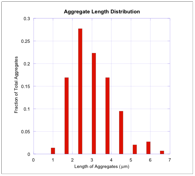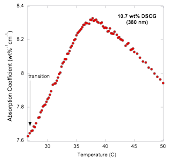

44893-B7
Aggregation and Liquid Crystal Properties of Two Chromonic Systems
The goal of the grant was to investigate two new dyes that form chromonic liquid crystals, Bordeaux Dye and Benzopurpurin 4B (top and bottom, respectively, in the figure below). The former has a structure quite different from the other dyes previously studied and the latter is reported to have a liquid crystal phase at very low concentrations.
Bordeaux Dye The research on this substance was completed a year ago and
the results were described in last year's progress report. During this past year, the results were
written up, submitted for publication, and appeared in the Journal of Physical
Chemistry B.
Benzopurpurin 4B Purification, determination of the phase diagram, and an
examination of the initial aggregation process were done a year ago and reported
in last year's progress report.
The crucial difference between Benzopurpurin
4B and many other chromonic liquid crystals is that
the aggregates are much larger.
Past light scattering experiments made this very clear, so this year two
experimental approaches were utilized for extract new information. First, more carefully designed light
scattering experiments were performed, and second, images of the aggregates
were made using confocal microscopy.
The new light scattering results at low concentrations
revealed a great deal about the Benzopurpurin 4B
system. After passing a solution
through a 0.2 µm nylon filter (thus forcing it out of
equilibrium), light scattering was able to record how the distribution shifted
to larger aggregates over time as it approached a new equilibrium. The correlation time after several days
was in the neighborhood of 4 ms. While this was taking place, however, the formation
of much larger aggregates was also evident, with these having a correlation
time around 150 ms. Interestingly
enough, the smaller the concentration, the faster these large aggregates formed
and the stronger their scattering intensity. Since the imaging investigation utilized higher
concentrations than the light scattering experiments, it was expected that
these larger aggregates would not be seen in the images. But these results did demonstrate that
depending on the nature and history of the Benzopurpurin
4B sample, very large aggregates might be observed.
Using the confocal microscope at
Swarthmore College, images of the Benzopurpurin 4B
aggregates were made. The samples
were placed between a microscope slide and a cover slip, which were pressed
together and sealed. The hope was
to make the sample as thin as possible, thus forcing aggregates to stick to the
glass and be easily imaged. This
technique was successful. Below
are three images taken 1, 7, and 15 days after filtration (left to right). The growth in
the length of the aggregates is clear, as is the tendency for them to form a
kink or even branch.
An image made shortly after filtering was analyzed in order
to determine the distribution of lengths.
As can be seen from the figure below, the average length is about 3 µm. What is so interesting about this
result is that it is not indicative of isodesmic
aggregation (the free energy change when a molecule joins an aggregate is
independent of aggregate size).
This type of aggregation is the leading candidate for chromonic liquid crystal systems, so these results cast a
good deal of doubt as to whether such a process is taking place.
It is of note that the widths of the aggregates do not
change as the length increases.
The widths in the images are only slightly larger than the limit of
resolution (as ascertained by imaging 5 nm nanocrystals),
so the typical width can only be estimated to be less than 50 nm. The relaxation time of a prolate ellipsoid 3 µm long and 50 nm wide is 4.3 ms, which
is typical of the relaxation times measured for the smaller aggregates in the
light scattering experiments.
A full examination of the literature has not been performed,
but this could be the first time individual aggregates of a chromonic
liquid crystal have been imaged.
Cromolyn This asthma drug is the most widely studied chromonic liquid crystal. In a recent preprint, extremely sophisticated light
scattering experiments indicated that aggregation began about 10°C above the
liquid crystal transition. The
existence of a critical temperature at which aggregates form is not
characteristic of isodesmic aggregation, which is
what many researchers believe describes the process in these systems. Since aggregation affects the
absorption spectrum, measurements were made to see if the absorption spectrum
begins to change shape at this point above the transition. As can be seen from the figure below,
by picking a wavelength affected by the change in shape, there is a clear sign
that the spectrum is affected by a process that begins about 10°C above the
transition.



